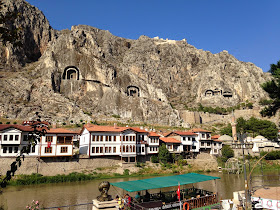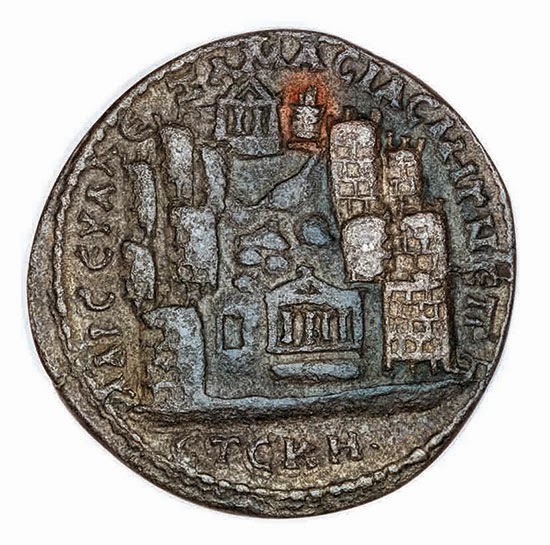Simin Uysal
It was almost two years ago when I had a powerful and mysterious dream. In the dream, it was twilight and I climbed a hill with an unidentified person beside me to see a cubic stone which I knew belonged to the ancient Hittites. I woke from the dream with a sense of urgency yet without a single clue about what to do. I am living on the same land where the ancient Hittites did almost 3,500 years ago and I've started reading about the Hittite civilisation but could find nothing related to this stone. I had no idea then that this dream was the mark of an adventure involving the ancient Gods of Anatolia, Pharaoh Ramses II and the Amazons!
Although I didn't know, the adventure began when I received an email from a dear friend of mine two months ago, asking me to work as a communication expert for a few weeks in an internationally funded project in the Black Sea region. I agreed but the timing felt interesting as I've been working on a book on a tight deadline. The task required traveling back and forth to the project site for almost six weeks and staying there during weekdays. We decided to drive together and during our journey, she suggested we visited Hattusha, the ancient capital of the Hittites on our way. I started having goosebumps while approaching the ancient city though the dream was long forgotten. We parked the car and started walking up the hill and entered the remains of the Great Temple. I was feeling very much excited and I saw it.....a green nephrite stone was there right before my eyes! I started recalling the dream.
 |
| Green Nephrite Stone |
I was still unsure about its significance and decided to think about it later as we had other interesting points to visit. As we were driving uphill towards the upper city, overlooking the planes, we saw a rainbow which felt like a message from the greatest deity of the Hittites, the Storm/Sky God Teshub . After walking through the Lion Gate and seeing another rainbow, we headed towards the sanctuary of Hattusha, Yazilikaya (inscribed rock in Turkish) to visit this holy place at the gates of Hattusha, the City of Thousand Gods.
 |
| Lions Gate at Hattusha |
There are two chambers in the temple and Chamber A was most impressive, where we saw a rock-cut relief of 64 gods. Mountain gods were also there with their scaled skirts symbolising the rocky mountains. We even saw the goddess Shaushka (Mesopotamian goddess Inanna/Ishtar). Walking between the ancient gods and goddesses, we finally reached the storm-god Teshub and the sun-goddess Hebat where Teshub stands on two mountain gods and the sun goddess stands on a leopard. e made our offerings and proceeded to Chamber B which was in better condition and the 12 Gods of the Underworld could be clearly seen carved on rock on one side and King Tudhalia IV of the Hittites in the embrace of God Sarruma on the other. We made our offerings again and continued our on our journey northeast.
 |
| Twelve Gods of the Underworld |
 |
| King Tudhalia IV in the embrace of God Sarruma |
I arrived at the project site which is a beautiful town by the Green River (ancient name Iris) and most impressive mighty Mount Harsena where the rock carved stones of ancient kings watch over the town. It is also the place where the ancient geographer, philosopher and historian Strabo was born around 63 B.C. According to Strabo, the name Amasia comes from Amasis, the queen of the Amazons, who were said to have lived here. The name has changed little throughout history: Amasia, Amaseia, Amassia and Amasia are all found on ancient Greek and Roman coins. Today, it is called "Amasya" in Turkish and all have the same pronunciation.
As I was briefed on the project, I learned the water coming from the mountain was being wasted because of the leakages in the system and the sewerage was being discharged directly into the Green River causing it great pollution. And it was most saddening and heart breaking for me to see the river polluted so badly and precious water being wasted in this beautiful place. The project is for building a wastewater treatment plant which will be commissioned in two months time, renewing the sewerage system and directing it to the plant instead of discharging directly the Green River and detecting and repairing the leakages. I believe the project will help the Green River which flows through three cities and many towns for 500 kilometers until it reaches the Black Sea, become cleaner.
 |
| Amasya - The Green River and the Rock Tombs |
The waking events finally seemed to be catching up with the dream. The green stone, as I learned later, is believed to be a present from Pharaoh Ramses II to the Hittite King though noone seems to be sure about its significance! When I think about the "nephrite", I am reminded of "nephritis", a kidney disease caused by toxins where the kidneys are inflammation can no longer purify the blood. The green nephrite stone, served as a great metaphor for the Green River, like the veins of the Earth carrying and circulating waters and the metaphoric existence of nephritis and it certainly inspired me on this assignment with the most unusual and inconvenient timing.
I felt this was a perfect opportunity to approach this assignment with Sandra Ingerman's teachings in "Medicine for the Earth". Being assigned the task of a "communication expert" of the project and having had the dream where I believe the spirits of the land supporting this, I thought, I had to first communicate with the Green River, Mount Harsena and the spirits of the ancestors. I took long walks by the river, sat with the trees on the mountain, carefully followed my dreams of the night and spent time with the inhabitants of the town before sitting behind the computer to write my report.
Walking by the river and watching others, I saw the depth of the trance we are in and how disconnected we are from nature which we are part of. Technology and modernity provide us with many comforts I am thankful for but our current way of life clearly does not support all of life, even the elements which give us life. With these feelings and thoughts on my mind, I started wondering how the ancient peoples were actually more evolved than our technologically advanced modern society. I decided to visit the local museum for some inspiration. As soon as I stepped inside, I saw an ancient statuette of the Storm/Sky God Teshub on display and recalled the recent visit to the temple where I saw King Tudhalia in the embrace of God Sarruma. I left the museum with a feeling of curiosity about this King.
When the Hittites came to Anatolia, to the "Land of Thousand Gods", they adopted the local beliefs and gods of the local Hatti civilisation. The existence of a god (or seeing everyhthing as sacred) for everything tells me a lot about their way of life in balance with and honouring nature. I later read it was the Hittites were the ones who constructed the first reservoirs, water ways and sewerage made of earthenware pipes in Anatolia. King Tudhalia IV, as I saw in carvings of the temple, was the one who has built 10 reservoirs. Water cult was an important element of the Hittite belief system and those who damaged water pipes or polluted the water were punished. The Hittites also carved shrines near springs and rivers which were considered as sacred, for honouring water deities.
 |
| 3200 years old Hittite reservoir built by King Tudhalia IV, discovered in 2002 |
There is clearly much to learn and be inspired from the ancestors of the land. We have all the resources we need for taking care of all life we are living with. It is not difficult but requires us to wake up.
I prepared my report with these feelings. The core message of the awareness raising actions is simple: "Water is sacred and everyone is responsible".
A press conference was held at the building site of the waster water treatment plant last week. I was pleasantly surprised to be greeted by a sweet friendly black dog when I arrived at the site which has become a sign (or a tail wag) from the universe since my beloved black dog died of old age a few years ago. This was not the only good sign because a ray of light between the mountain peaks started lightening exactly the area we were standing while the mayor was speaking and saying "as a municipality, we are dedicated to honouring nature. we owe this to our descendants." I was also pleasantly surprised to learn the municipality have started producing electricity from the solid waste because I worked on a solid waste management project around 2009 involving rehabilitation of the dumpsites to protect soil and ground water and also recycling of solid waste.
Working in the narrow cobbled streets of the town the next day and enjoying the warmth of the November sun, I came across a door with the figure of the Hittite Sky God carved on it and inscribed "Teshub's Mansion". My heart was smiling with the confirmation that the ancient gods and ancestors of this land were supporting every action honouring all of life. Ancient peoples of Anatolia had ceremonies and rituals and shrines. They also honoured the gods/spirits as a way of life, in everything they were doing as daily activities. After the Hittite civilisation disappeared and Phyrigians established their state on the same land, they continued honouring the ancient mother goddess of Anatolia, Cybele by considering everything under the sky as her temple.
The relationship between ancient peoples and nature is most inspiring. They did not have electricity, car or smart phones but they were smarter than us today to know their lives depended on honouring all of life.
The adventure continues and I will be training municipal staff on commmunication techniques in a few weeks time. My dream followed by the recent developments, have restored my hope in these projects and now I am working with lots of wonderful inspiration from Medicine for the Earth (which I think needs to be taught in schools and workplaces!) which Sandra Ingerman teaches and shares with great generosity with the world. I feel that I am now a completely different communication expert than I've been in the past twenty years :-)
 |
| The door inscribed "Teshub's Mansion" |
 |
| Teshub - Storm/Sky God of the Hittites |









